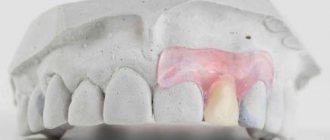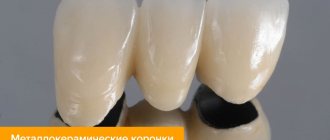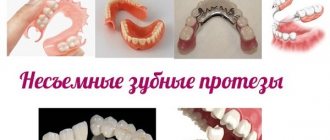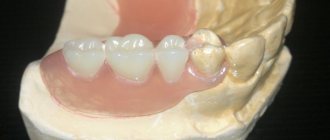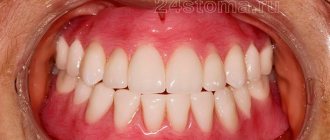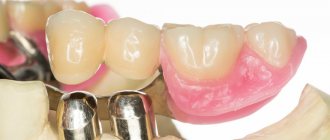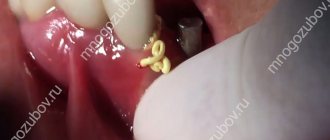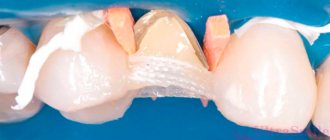What causes allergies
An allergy to a dental crown, like any allergy in principle, is a pathological reaction of our immunity, which is expressed in increased sensitivity (hypersensitivity) to some allergen substance. It is interesting here that sensitization or stage 1 occurs first - when the body first encounters an “unfriendly” substance in very small quantities. At this stage, the components of the immune system - B lymphocytes, T helper cells, mast cells, endothelial cells, dendritic cells - react weakly. That is, there are no tangible manifestations1 of an allergic reaction yet.
At stage 2, when the body encounters a large amount of allergen, the allergic reaction itself occurs, with all its manifestations and symptoms (more on them below). Moreover, from the 1st to the 2nd stage, very little time can pass - literally a few minutes or hours. Especially if the allergen is strong enough - in principle or specifically for you as an individual.
Only until 15.01 South Korean implant Osstem - from 18,500 rubles.
Hurry up to sign up for a free consultation and lock in promotional prices.
Call now or request a call
Opening hours: 24 hours a day - seven days a week
What is a denture allergy?
An allergy in general is the body's immune response to an allergen irritant to which the body has developed an increased sensitivity or hypersensitivity. This allergen can be found both in the external environment and appear inside the body through the interaction of certain substances. The immune response to an irritant can manifest itself both locally, in one place where the allergen acts, and as a whole affect the general condition of the body, leading to systemic disorders.
An allergy to prosthetic structures, in turn, is a reaction to the components of artificial dental structures, which is most often detected after their installation and manifests itself in the form of swelling, redness, rash on the oral mucosa and other symptoms (we will discuss them below).
Symptoms of an allergic reaction
Allergies can appear either immediately after prosthetics or over a longer period of time - after several days, weeks or months, or less often after several years. Therefore, you need to know what symptoms are signs of an allergic reaction. How an allergy to crowns manifests itself (and there can be either one symptom or several at once), we will describe further:
- problems with the gums and mucous membranes: redness, itching, pain, swelling, rash, sores, blisters with fluid inside - all this may indicate allergic stomatitis,
- unpleasant sensations on the tongue and palate: numbness, tingling, burning, goosebumps, metallic or sour taste,
- disruptions in the production of saliva: too much or too little of it is formed, dry mouth appears,
- nasal congestion, runny nose, sneezing,
- pain and sore throat, dry cough, pain when swallowing,
- the appearance of rashes or red spots on the skin (on the face, neck, chest, arms),
- tearfulness, redness of the eyes,
- exacerbation of existing body diseases: asthma, gastrointestinal pathologies, etc.,
- temperature increase,
- enlarged lymph nodes,
- Quincke's edema: a very dangerous condition in which some part of the body or face or neck becomes severely swollen. The danger is that due to swelling of the neck and throat, it becomes difficult to breathe (you can even suffocate). Blood vessels that supply oxygen to the brain may also be pinched.
Reasons associated with the development of allergies to prosthetic materials
The cause of an allergic reaction may not be an immunopathological process, but an individual reaction of the mucous membrane associated with the use of a denture.
Allergies can occur due to:
- mechanical trauma - deterioration in fixation of the product injures the tissues of the oral cavity;
- “greenhouse effect” - an increase in temperature under the prosthesis leads to loosening of the mucous membrane, which contributes to greater penetration of monomers into the body;
- increasing the acidity level of saliva - as a result, the processes of corrosion of metal structural elements are accelerated;
- wear of the denture - accompanied by an increase in the concentration of substances that can cause allergies.
What materials provoke allergies?
The following substances can provoke an allergic reaction in orthopedic dentistry:
- synthetic polymers: plastic, nylon, acrylic, etc.,
- metals: base metals are more likely to become allergens than noble metals,
- anesthetic drugs, filling compounds, antiseptics: if used incorrectly, they can cause local irritation,
- dental cement on which dentures are glued.
But ceramics, zirconium and aluminum dioxides, composite materials for filling, as well as titanium without impurities are considered hypoallergenic.
Don't know what type of prosthetics to choose?
We will help in the selection, advise where to read more information and compare types of prosthetics.
Consultation with an orthopedic doctor in Moscow clinics is free! Call now or request a call
Working hours: from 9:00 to 21:00 - seven days a week
However, there is still no material for prosthetics that is 100% inert, i.e. There is always a risk of allergies - to a large extent it depends on the person himself, his individual reaction. At the same time, modern high-quality materials are very well cleaned at the production stage, and the maximum amount of harmful substances is removed from them. Therefore, they can cause problems extremely rarely - in 1 case out of a million or even less often.
Plastics and acrylic are the most allergenic materials
According to research, synthetic polymers - plastic, polyurethane, nylon, acrylic - provoke an allergic reaction in approximately 1% of cases, i.e. in 1 in 100 people. In principle, this is not little, but not very much either. As a rule, plastic crowns are often placed only on a temporary basis - so that the patient does not go without a tooth while more durable permanent ones are made. So a large concentration of potential allergens should not have time to accumulate in the tissues. But still, slight irritation of the gums or allergic stomatitis can appear in people with high sensitivity and a weakened body.
If we consider the acrylic from which artificial gums are made (it is sometimes built up around bridge crowns if the gum contour is not very smooth), then the allergen here is the acrylic monomer. But today there are materials with low monomer content or without it at all - for example, Acry-free.
Ceramics and zirconium dioxide are the lowest allergenic materials
Allergies to ceramic crowns occur very rarely – almost never. The same can be said about allergies to zirconium crowns (made of zirconium dioxide) and aluminum dioxide (metal-free ceramics). Ceramics is considered one of the most low-allergenic and inert materials in dentistry. But an individual allergic reaction still sometimes occurs, for example, if dyes were used to make the prosthesis. Or, if a ceramic crown is placed on a core inlay or implant that contains allergens (aluminum, nickel, vanadium). That is, the problem here is not in the ceramics, but in what is underneath it.
Read on the topic: ceramic metal-free dental crowns - what they are and how relevant they are today.
First aid and treatment methods
The main task when an allergic reaction occurs is to eliminate its source as quickly as possible. With a removable structure, this is easy to do; just remove it. In the case of dental crowns, you should make an appointment with a prosthodontist. Until this point, it is recommended to rinse your mouth with antiseptic solutions.
Experts advise immediately taking an antihistamine (for example, Claritin or Tavegil) if you have allergy symptoms. With the help of the drugs “Enterosgel” or “Smecta” it will be possible to quickly remove the allergen from the body. If soft tissues are damaged, healing gels (for example, Cholisal) can be applied.
If you experience severe pain, you are allowed to take a non-steroidal anti-inflammatory drug (for example, Nise). In advanced situations, if the pills do not help, you should call emergency help. If an allergic reaction occurs, it is important to replace it with structures made from hypoallergenic materials. This is the only way to cope with the disease.
To exclude the possibility of developing allergies, it is recommended to use metal-free dentures
Allergic reaction to metals
An allergy to a metal crown can occur if, for example, the alloy is not of very high quality, is improperly processed, releases toxins, allergens, or is itself chemically active in the tissues in the oral cavity or in the liquid environment. Experts estimate that about 10% of the world's population is susceptible to metal allergies. Ideally, the metal for prostheses is inert, i.e. Fully compatible with the human body - does not cause inflammation, is not rejected. Let's consider which metals often provoke an allergic reaction:
- nickel: an inexpensive, highly allergenic metal, which contains 9% of stainless steel,
- copper: due to its properties, color and not very high price, it is often alloyed with gold to obtain a relatively inexpensive “noble” material. However, copper oxidizes quickly and often provokes an allergic reaction - almost as often as nickel.
- zinc: included in cements for filling, incl. root canals before prosthetics. May cause irritation, but quite rarely,
- cobalt and chromium: they provoke allergies less often than other base metals, but can release toxins,
- titanium alloys: titanium itself is almost 100% inert, i.e. should not provoke allergies. However, in dentistry, its alloys are often used, where the titanium content is 85-98.7%. Therefore, the purer the alloy, the lower the risk of an individual allergic reaction. Titanium products are coated on top with a film of titanium dioxide, which eliminates corrosion,
- aluminum and zirconium (in the form of dioxides): zirconium and aluminum dioxides are inert compounds, but in exceptional cases they can be allergenic,
- silver, platinum, palladium, gold (noble metals): also considered inert and hypoallergenic, but it all depends on the concentration of the base metal in the alloy. If it contains a lot of additives (nickel, chromium, copper), then an allergic reaction is possible.
How are allergies to dentures treated?
The first thing to do if you experience discomfort from the prosthesis is not to wait for it to “go away on its own.” The removable denture must be removed from the mouth independently as quickly as possible so that the allergy does not develop to a dangerous state. If a permanent structure is installed, you must contact your nearest dentist to have it removed. The unpredictability of the reaction makes it difficult to delay, since symptoms can develop in a few minutes.
Treatment of allergies consists of eliminating the symptoms of an immune reaction, and the mechanism of development of the immune response to an irritant cannot be canceled, since it is “built-in” into the body’s natural defenses.
In this regard, symptomatic treatment of allergies to dentures is carried out and further reliable determination of the allergen that caused the original problem. First of all, under the supervision of an immunologist or allergist, the patient should take antihistamines that reduce sensitization - hypersensitivity to an irritant. If angioedema occurs, hormone therapy is also carried out, including the use of adrenaline.
Good to know! In emergency cases, when the airways are completely closed, when rapid and severe swelling of the larynx has developed, a conicotomy is performed - a resuscitation procedure to dissect the trachea below the larynx to ensure air flow to the lungs. But, of course, in a clinical setting, this procedure should only be performed by a doctor.
Correcting the situation directly with prostheses is possible in three directions. After initial treatment aimed at eliminating symptoms, the patient may be offered the following solutions:
- installation of other structures that do not contain the detected allergen. As a rule, these are higher quality and more expensive models. The use of new designs is possible no earlier than 4 weeks after treatment,
- screening of the existing structure using hypoallergenic materials, namely alloys of noble metals, such as gold or platinum. To do this, the prosthesis that causes allergies is covered with non-allergenic material - shielded,
- refusal of prostheses and choice of an alternative method. In particular, implantation using hypoallergenic materials for the artificial teeth themselves.
Metal-ceramics and metal-plastic
Can there be an allergy to a metal-ceramic crown? Here, the likelihood of an allergic reaction depends on the quality of the materials, in particular the metal used. For example, often an allergy to a metal-ceramic crown occurs if the base cap is made of a nickel alloy rather than gold or titanium. Or, for example, this option - if the metal-ceramic crown is ordinary, i.e. not on the shoulder mass, then it will provoke an allergic reaction much more often. As the gums eventually begin to come into contact with the metal along the edge of the crown, allergens will accumulate in them.
Read on the topic: metal-ceramic crowns - what they are, on the shoulder mass and ordinary ones, for whom they are suitable.
In metal-plastic materials, both metal and plastic can become an allergen. Therefore, such products should not be worn for longer than the prescribed period - several weeks or months. Or place them on artificial gums so that the edges of the crowns do not rest on the mucous membranes.
Irritation due to galvanic syndrome
Galvanic syndrome is a condition when an electrical impulse occurs between prostheses made of dissimilar metals. Moreover, crowns can be metal, metal-ceramic, or metal-plastic (the main thing is that metal is present). Galvanism occurs not only between crowns, but also between crowns and other prostheses. For example, clasp with metal hooks or a palatal bridge, as well as implants (less often). There is a tingling sensation in the mouth, an “electric sensation,” and a sour or bitter taste.
The occurrence of galvanism depends on how dissimilar metals are able to interact with each other (how different their electrochemical activity is), and not on the quality of the metals themselves. Therefore, you should always be interested in what crowns are made of and report this important information to the dentist during subsequent prosthetics. According to statistics, 15-35% of orthopedic dentists’ patients experience galvanic syndrome. For example, galvanosis may appear due to the presence of gold and nickel-chrome prostheses.
What causes allergies?
It is clear that some materials can cause an allergic reaction on their own. Dentists and dental technicians, of course, know about this and try to process materials and make dentures in such a way as to reduce allergenicity to a minimum. But sometimes provoking factors come into play, for example, the following:
- chips, abrasions and cracks that expose the inner layers of the prosthesis: as a result, allergens enter saliva, gums,
- loose fit of the crowns to the gums and supporting teeth: therefore, when chewing, the material in contact and poorly treated areas begins to actively “give off” components, incl. allergens. They are absorbed into the gums, penetrate the blood vessels, saliva,
- poorly manufactured dentures: improper mixing of material components, too high or low processing temperature, etc.,
- changes in the composition of saliva due to certain diseases of the body (diabetes, gastrointestinal problems), climate change or even the region of residence, where the water composition is different,
- natural aging of the prosthesis, i.e. end of its service life,
- installation of a new prosthesis made of a different material (with metallic inclusions): provokes galvanosis.
%akc72%
Prevention of allergies to prosthetic materials
Consultation with an allergist-immunologist, laboratory tests, careful collection of anamnesis - these measures will help to create a complete picture of the disease and avoid consequences associated with allergies.
On the patient's part, it is important to remember the following rules:
- if one of the allergy symptoms appears, it is necessary to remove the removable denture from the oral cavity;
- if the structure is not removable, seek help from a dentist at any nearest clinic;
- the gradual development of an allergic reaction requires taking an antihistamine and a mandatory visit to the dentist.
If you suffer from increased allergic sensitivity of any origin, then it is important to approach the choice of material used to install the prosthesis with great responsibility.
First aid at home
If you notice characteristic symptoms of an allergic reaction, you should immediately remove your dentures - if they are removable. If they are not removable, rinse your mouth and take an antihistamine. For example, “Suprastin”, “Fenistil” drops or “Tavegil”. They are considered the most powerful, but with side effects such as drowsiness and slower reactions. Next, you should immediately contact the dentist who placed the prosthesis. While you are waiting to see a doctor, eliminate any potential allergens from your environment - citrus fruits, chocolate, ketchup, dust, and have less contact with animals. Because it is possible that an exacerbation of some “old” allergy has occurred.
If there is sudden swelling of the face, neck, arms, legs, it becomes difficult to breathe, or a rash appears all over the body, then immediately call a doctor or an ambulance.
Methods for diagnosing allergies
Establishing the cause of allergies requires consultation with an allergist-immunologist and certain diagnostic procedures.
After a visual examination of the patient and collection of anamnesis, the following tests are prescribed:
- intradermal - by introducing the suspected allergen into the skin;
- scarification - a solution of allergens in the form of drops is applied to the skin in the area of the forearm and back;
- application - application of a skin test containing the suspected allergen for a certain time;
- elimination - removal of the prosthesis from the oral cavity for a week;
- exposure - after the allergy symptoms disappear, they begin to use the prosthesis again.
